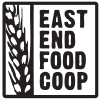At the Co-op, we always focus on environmental responsibility. We go out of our way to ensure we are doing the least harm to the world around us. It’s evident in our product sourcing and selection–the things shoppers see on our shelves every day: milk in returnable glass containers, on-tap kombucha, organic and locally-sourced produce, products that are fair trade, non-GMO, B-Corp Certified, and cruelty-free, and the most expansive bulk food and bulk herbs department in the City. There are no plastic bags at our checkout (we eliminated those eleven years ago), and we’ve been composting for nearly a decade. It is inherent in our culture at the co-op to reuse, reduce, and recycle. But with rapid changes in the global recycling market and renewed attention on the impacts of single-use plastics on our environment, we were spurned to look even closer at our contribution to the waste stream. We asked ourselves, “how can we be even better stewards?”
The East End Food Co-op spent the past year focused on evaluating our practices, our packaging, and our culture searching for improvements. We made some quick changes (the “low hanging fruit” as it were) including eliminating plastic straws, switching to compostable take-out containers, replacing plastic produce bags with compostable bags (though they aren’t universally loved), providing organic cotton canvas bags in bulk and produce, ensuring plastic containers were recyclable where available, training our supervisory staff on changes in the recycling stream, updating signage in front of house and back of house, finding an outlet for waxed coated cardboard, and providing consumer education about zero-waste shopping techniques. We even ensured that our annual staff gift was sustainable (sweatshirts made from organic and recycled cotton). We made these changes having no one person on staff dedicated to sustainability and with no specific expertise. We knew we were limited in our ability to change if we weren’t 1. Experts, and 2. Measuring and analyzing our real impacts on the environment.
We needed guidance so we could better design a sustainability plan with tangible, actionable goals. We secured the services of our regional experts, the Pennsylvania Resources Council (PRC) to conduct a waste audit. The audit’s purpose was to determine the composition of the Co-op’s waste stream and provide recommendations for improving current waste diversion measures. The data collected serves as our base of information, and future audits will allow us to track progress and identify additional opportunities to increase waste diversion.
After an initial site visit by PRC, we selected two dates for waste collection to capture fluctuations in waste generation, which is heavily influenced by the number of delivers we receive and the number of customers we serve. A total of 1,767.7 lbs of material was collected from six points of generation and manually sorted by PRC and EEFC staff during the waste audits on Saturday, June 22 and Tuesday, June 25. All material was weighed and recorded by point of generation and waste stream type to identify contamination and subsequent education needed for Co-op staff working in that area.
The baseline waste diversion rate with the Co-op’s current waste management system is 84%, based on the average of two 24-hour waste collection periods and manually sorting, categorizing, and weighing 100% of the sample size: 44% recycling, 39% compost, 16% final disposal, 1% food donation.
By using the average waste generated over two days, and considering the variability of high waste yielding PRC estimated the amount of waste generated over an entire year of operations at the Co-op. Over 362 days that the Co-op is open to the public, the Co-op will divert approximately:
– 72 tons of recyclables;
– 70 tons of compostable material;
– 4.5 tons of food recovered for in-house food preparations; and
– 2 tons of food donations to nonprofit organizations.
The primary objective of conducting a waste audit is to understand the composition of the waste and the current diversion methods to identify areas that could be improved and/or new opportunities to increase waste diversion. With a few tweaks to our current system, we have the opportunity to reach a 92% diversion rate. We look forward to implementing suggestions by PRC and will continue to educate, inform, and involve our staff and members in the process.
by Kate Safin, Marketing & Member Services Manager (East End Food Co-op)
Data and waste analysis provided by Stacy Albin, Environmental Program Coordinator (PA Resources Council)



Leave A Comment